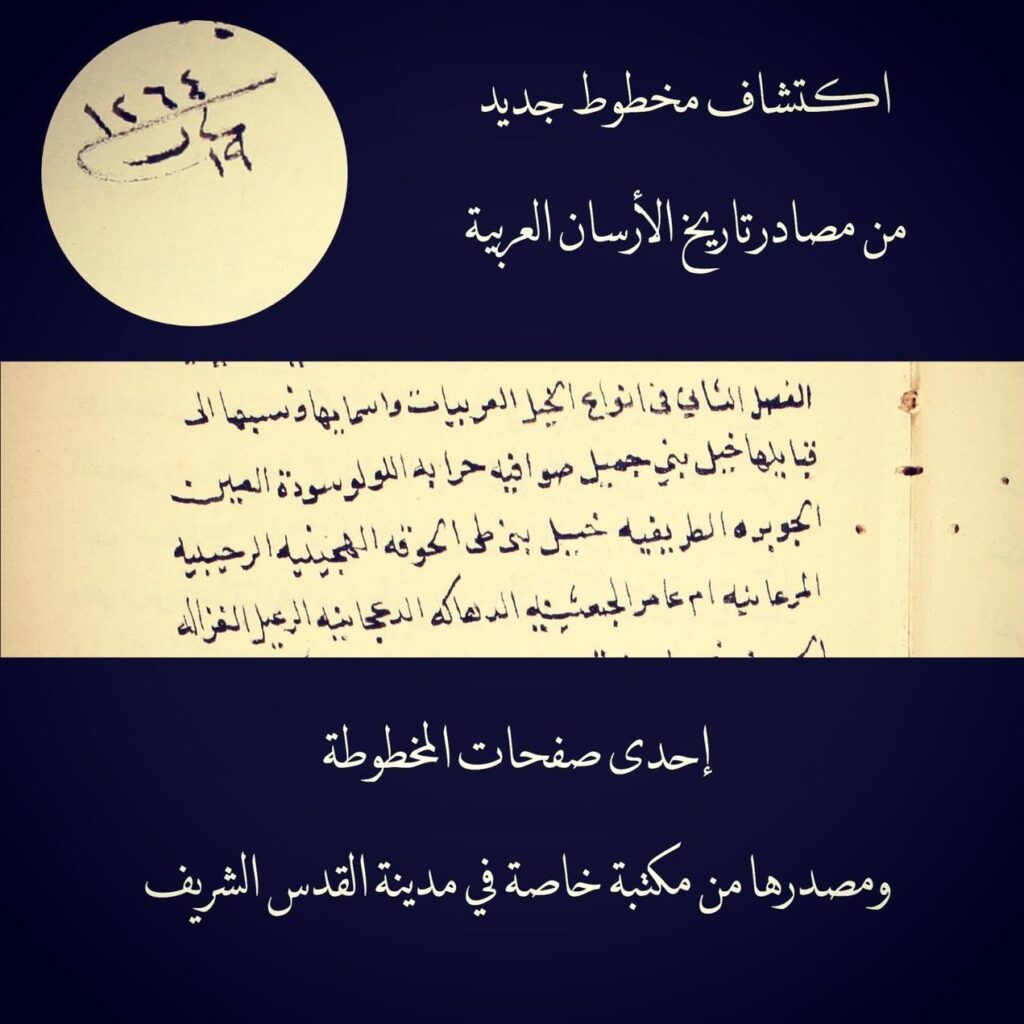New Arabic manuscript on strains surfaces with Bait al-Arab
Bait al-Arab Kuwaiti researcher Yahya al-Kandari found a manuscript on Arabian horse strains in a private library in Jerusalem. The manuscript seems to date from 1264 Hijri, equivalent to 1848 CE. The handwriting is indeed characteristic of the mid-XIXth century Arabic script.

I am eager to learn more, but for now, I will take what’s in that screenshot, which Radwan Shabareq sent me. It says:
The second chapter is on the types of Arabian horses (al-khayl al-‘arabiyyaat), their names and their affiliation with their tribes. The horses of Bani Jamil: Sawafiyyah, Haraabah, al-Lulu, Sawdat al-‘Ayn, al-Juwayrah, al-Trayfiyyah; the horses of Bani Tay: al-Hawqah, al-Hajiniyyah, al-Ruhaybiyyah, al-Mar’aaniyyah, Umm ‘Amer, al-Ju’aythiniyah, al-Dahhakah, al-Da’jaaniyah, al-Ru’ayl, al-Ghazalah…
Some strains I recognize, many I do not. The Bani Jamil, also known as al-Mujamma’, are a large Bedouin tribe settled in Iraq, in the province of Diyala. Their area of settlement is along the Tigris river, from Tikrit to Balad with a concentration around Samarra’. Of the horses listed under them, I recognize the strain of al-Haraabah and the much older strain of al-Trayfiyyah.

The Tai mentioned in that snippet are not the segment of this tribe settled in North East Syria around al-Qamishli and Tall Hamees, but rather their Iraqi brethen, settled to the north of the Bani Jamil towards Mossul. Among their strains I recognize are the Umm ‘Amer and al-Ju’aythiniyah (Yasser Ghanim’s mare Bushra is from the strain), al-Da’jaaniyah (a very old strain, 700 years old according to the Juhaysh Bedouins), al-Ru’ayl (from which the strains of al-Harqah is deribed), and al-Ghazalah (another old strain with ‘Anazah, today present with the Tai of Syria but not registered).
Shadow Edward. I don’t know how to say that you were the one who discovered this manuscript !! In fact, I was the one who discovered it and published it on social media this morning. You should mention this as a matter of scientific honesty
Hello, Yahya. I never said I discovered it! I said someone (Radwan Shabareq from Aleppo) sent this screenshot to me without further information about the finder. Now that I know that’s it’s you (thanks to Yasser Ghanem) I revised it and added your name. I have no interest in taking credit from others. I wish you and Bait al-Arab good luck in publishing it and look forward to reading a copy.
Dear Mr. Edward
Thank you very much first for your answer, and for your scientific honesty secondly, I have the honor to communicate with you. So please kindly send me a message on my email y9299@hotmail.com.
Regards
It’s my pleasure.